Atmospheric Ocean
| Controls | Mouse | Keyboard |
| Rotate Camera | Left Click + Drag | Arrow Keys
or W A S D |
| Zoom | Scroll Wheel | - / + Keys or Q & E |
Atmospheric Ocean
Colton Hash: Ocean Networks Canada Artist in Residence
instagram: @colton.hash
Project Description
Atmospheric Ocean is an interactive data art application that presents an abstraction of physical processes that cycle carbon dioxide between the air and sea. The viewer is placed within the dynamic mixing layer between the ocean and atmosphere. Carbon is represented in various forms and spreads between the air, surface water and deep ocean. The processes visualized in Atmospheric Ocean include CO2 absorption, photosynthesis, decomposition, carbonic acid formation and CO2 venting from the ocean. Seasonal fluctuations are shown in sea water temperature, solar radiation, cloud formation and wind driven upwelling currents. Atmospheric Ocean includes hydrophone recordings associated with an annual cycle as background sound. These recordings include sounds from marine organisms as well as subtle echos of human impact. Distant terrain features define a specific context to the environment of Atmospheric Ocean, placing viewers at the head of the submarine Barkley Canyon, with the Olympic Mountain Range and Vancouver Island visible on the horizon. This location is where the Salish Sea flows into the Pacific Ocean, and is the edge of the North America’s western continental shelf. This region is part of a “permanent upwelling zone” along the west coast of North America, where wind driven currents provide nutrients from the deep ocean throughout the summer months.
Viewers control the virtual camera of Atmospheric Ocean, allowing focus on specific elements of this complex scene. Viewers can also interact with controls to fade out individual processes, allowing them to clearly associate visuals with specific environmental relationships. This information panel also has controls to scroll through the annual cycle of these carbon cycling processes systems. Atmospheric Ocean places viewers in an immersive scene populated with representative elements of physical and geological processes governing carbon dioxide cycling between the ocean and atmosphere. The relationships expressed by this exploratory application may give rise to an emergent understanding of the these processes, sparking an appreciation for the complexity of these interconnected systems. Although Atmospheric Ocean has a specific context, it serves as a microcosm for the interconnections between the world’s oceans and our global climate.
Input Data
Atmospheric Ocean is driven by data from NASA satellites, NARR historical climate models as well as data from Ocean Networks Canada, which operates a deep sea laboratory in the Barkley Canyon. This temporal data is used as input to create animated representations from variables such as seawater temperature, seawater CO2 content, solar radiation, atmospheric CO2 concentration and the exchange of CO2 between the seawater and air over an annual cycle. Various hydrophone recordings collected from the Barkley Canyon are composed to create a dynamic soundtrack that fluctuates with the seasons. The data used in Atmospheric Ocean is composed with artistic intuition, intended to curate an immersive scene of interconnected environmental processes.


Scientific Description
| The net fluxuations of carbon dioxide between the atmosphere and oceans are critical to understand Earth’s interconnected climate system. Atmospheric carbon dioxide dissolves through surface seawater and accumulates into the warm, shallow mixing layer directly below. This dissolved CO2 may be absorbed by photosynthesis, form into carbonic acid or be slowly mixed into the deep ocean through cold water formation.
The ocean currently absorbs about one third of the CO2 emitted by human activity, primarily through photosynthesis. Phytoplankton, which are plant-like microorganisms, can reproduce extremely rapidly with available sunlight and nutrients. They are the basis of marine food webs as they create massive sources of food for higher trophic levels. These population blooms absorb enormous amounts of CO2. However, their decomposition may consume dissolved oxygen in seawater, potentially creating large anaerobic dead zones. Most of Earth’s oil and gas deposits were produced by ancient populations of phytoplankton. About a third of the carbon absorbed by phytoplankton is directly sequestered into the deep sea. Carbon uptake by the ocean is influenced by global weather patterns and seasonal changes in available sunlight. The capacity of seawater to absorb gas depends on mixing in the upper water column, largely dependent on temperature differences between density layers. Carbon dioxide can vent back into the atmosphere, rising from the saturated deep ocean water with wind driven upwelling currents. The rates that sea water absorbs and vents carbon dioxide varies between regions and change throughout annual and decadal cycles. The potential of seawater to absorb and store carbon dioxide decreases as temperatures warm, suggesting that oceans may have decreased capacity to sequester carbon dioxide in the future. The ocean also absorbs carbon dioxide when it reacts with dissolved calcium, creating carbonic acid and bicarbonate which accumulate in the deep ocean. In particular regions, such as the Salish Sea, acidified water can upwell to the surface, increasing the Ph of local marine environments. Ocean acidification can limit production of many plankton species, and cam severely impact corals and shell building organisms. Ocean acidification is projected to increase with atmospheric carbon dioxide concentrations. Much of the carbon dioxide that the ocean absorbs is carried into the deep through the relatively slow thermohaline circulation patterns which connect the world’s oceans. It may take many centuries for this acidified water to upwell back into surface waters, meaning the impacts of ocean acidification will continue to intensify for hundreds of years. |
Links for more information:
The Ocean’s Carbon Balance (NASA Earth Observatory)
Introduction to the Barkley Canyon (Ocean Networks Canada)
What is Ocean Acidification? (NOAA)
Thanks to: Zelalem Engida, Megan Kot, Dwight Owens, Kim Juniper, Lesslie Elliott, Mandy Leith, Paul Walde, Ashton Sciacallo
| Status | Released |
| Category | Other |
| Platforms | HTML5 |
| Author | Colton Hash |
| Made with | Unity |
